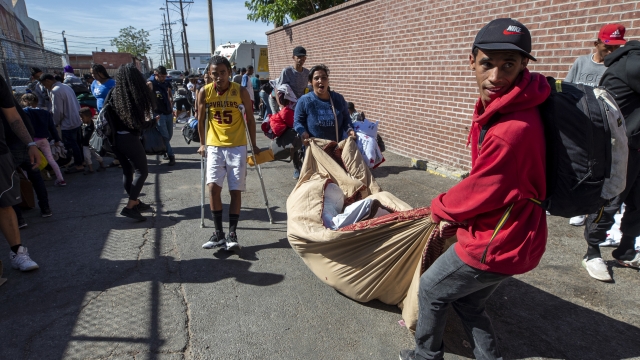U.S. and Mexican officials announced an agreement to tighten immigration policies as the United States inches closer to the end of Title 42. Title 42 will expire on May 11, and cities along the nearly 2,000-mile southwest border are bracing for an influx of migrants.
The pandemic era policy allows U.S. officials to quickly expel migrants. It went into effect in March of 2020 and has been used to expel nearly 2.8 million migrants, according to statistics by U.S. Customs and Border Protection.
In recent days, officials in California, Arizona, and Texas, said migrant crossings have increased.
In El Paso, Texas, hundreds of migrants slept outside on the streets.
This week, U.S and Mexican officials announced an agreement with new immigration policies. Mexico agreed to continue to accept migrants from Venezuela, Haiti, Cuba, and Nicaragua who are turned away at the U.S. border.
A press release on the Mexican government website stated that the U.S. reaffirmed its commitment to receive more then 100,000 people from Honduras, Guatemala, and El Salvador under a family reunification permit program.
The Biden administration is setting up hubs outside the U.S. where migrants can apply to settle in the U.S. Spain, or Canada. The first centers will open in Guatemala and Columbia. New immigration measures also include quick screening at the border for people seeking asylum. People who do not meet the asylum criteria will be deported.
As efforts along the border are ramping up, the Biden administration is sending 1,500 active-duty troops to the southwest border for 90 days to provide support ahead of the surge in crossings. The military personnel will not perform law enforcement functions or interact with immigrants, according to White House Spokeswoman Karine Jean-Pierre.
In Texas, El Paso and Brownsville have both declared a state of emergency.
SEE MORE: Retired Lt. Gen. Honore says 1,500 troops not enough at the border
El Paso Mayor Oscar Leeser held a press conference on April 30 to lay out his plan to deal with the surge of migrants expected to pass through El Paso.
"We figure it's anywhere between 10,000 to 12,000 people that are ready to come on May 11, May 12. We do know that additional people are coming right behind them," Leeser said.
Leeser said he visited shelters and encampments in Ciudad Juárez, Mexico, and said many believe the false narrative that they can come to the U.S. without documentation.
Leeser expects migrants to be in El Paso for 24 to 72 hours. Two school buildings will be used to shelter migrants, and the Red Cross will provide meals for migrants waiting to reach their destination. Leeser assured residents that federal money will be used to care for migrants, not local tax payer dollars.
In San Ysidro, California, migrants behind the border wall said they came from Ghana, Columbia, Haiti, India, and Jamaica.
"We don't want to go back home to the violence," a man from Jamaica said.
Last April, Texas Republican Governor Greg Abbott began busing migrants out of Texas to Democratic-led cities to protest the Biden administration's handling of the influx of migrants illegally crossing the U.S. border. The program has been controversial.
On Wednesday in New York City, Manuel Castro, the Mayor's Commissioner of Immigrant Affairs greeted a bus of migrants arriving from Texas.
"We have been welcoming anywhere between two to 300 people a day for quite some time now. And with these buses restarting, we could expect over 1,000 people a day, which is incredibly difficult for us," Castro said.
He said they're running out of shelter and called on the federal government to step in and help as they brace for an increase in migrants.
Watch KGUN 9's hour-long special presentation, Cruzando la Linea: Crossing the Line 2023 only on our website and all our digital platforms. Our news team takes a deeper look at the issues impacting Arizona's southern border.
Trending stories at Scrippsnews.com



